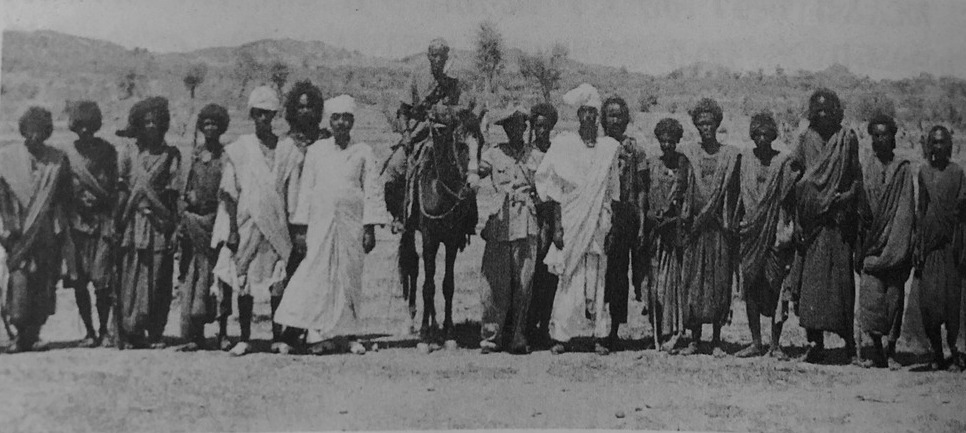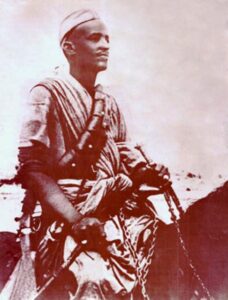Early life in Italian Eritrea
Awate was born in 1910 in Gerset, located between Tessenei and Golluj in southwestern Italian Eritrea. His father, a peasant, trained him as early as childhood in the use of guns. Hamid belonged to the Tigre ethnic group.
In 1935, Hamid was conscripted by the Italians to serve in the colonial army of the Eritrean Ascari. Beside his fluency in Arabic, Tigre, Tigrinya, Nara, Hedareb, and Kunama, Hamid learned the Italian language very well within a short period of time and was sent to Rome for a course in military intelligence.
After returning from Italy, he was appointed as a security officer in western Eritrea. Shortly after, he served as deputy chief (Mayor) of the city of Kassala (Sudan) and its surroundings during the brief Italian occupation of that city in 1940/1941 at the beginning of World War II. As Mayor of Kassala he promoted the political union of that city to his country, Eritrea, but the British attack at the end of January 1941 forced him to renounce to it.

He fought as an Eritrean ascari in the Battle of Keren and participated in the Italian guerrilla war in Eritrea against the British and Ethiopians in World War II with the cavalrymen of Ali Gabre.
After the victory of Great Britain against Italy in World War II in Eritrea, Hamid settled in western Eritrea but eventually went into a dispute against the British authorities and began an armed campaign against the British presence in Eritrea from 1942 to 1949. Afterwards, Hamid and his armed faction came to a truce agreement with the British authorities.
In the meantime, the Eritrean independence movement was taking shape and working towards making Eritrea an independent country by peaceful means rather than joining landlocked Ethiopia.

Resistance against Ethiopia
In 1958 a group of Eritrean exiles in Cairo founded the Eritr
ean Liberation Movement under Hamid’s leadership.
In July 1960, in the city of Cairo, a group of young Eritrean students and intellectuals held a meeting and formed the Eritrean Liberation Front (ELF).
Back home, the Eritrean authorities were suspicious of Hamid’s movements and activities and were watching him closely. Eritrean police forces planned to arrest Hamid in his village in August 1961. Turkey explains that the Ethiopians deployed a large amount of police forces but their plans were foiled by an Eritrean Muslim within the Eritrean police who informed Hamid earlier of that plan. Hamid then fled to Mount Adal located to the west of Agordat.
Hamid’s decision to begin armed resistance was reached after a period of long deliberations with other Muslims. In an interview with Eritrea Al-haditha, issue #75, second year, pioneer Mohammed Al-Hassan Dohen, a long time friend of Hamid and Hamid’s assistant when he was district chief, says: “In the year 1960, Idris Mohammed Adem sent a message to Hamid. Hamid Awate told me that Idris Mohammed Adem was asking him to declare the armed struggle; but he was not ready for it at that time. After four months, Mohammed Al-Shiekh Daood came and asked Hamid to declare the revolution. Hamid agreed to lead the armed struggle and declare the revolution but asked for money and weapons as long as he was notorious Outlaw. Mohammed Al-Shiekh Daood braved Hamid with old arms, three five bullet rifles “abu khamsa” and gave him 3 Birr with sugar and tea all was provided throw Egyptian Muslims. In addition, Ibrahim Mohammed Ali brought two rifles.
On 1 September 1961, eleven rebels led by Hamid attacked police posts in the west of Eritrea include one on Mount Adal. A fierce battle ensued between Hamid’s and Eritrean police forces, lasting 30 minutes ending in a stalemate.
Death
On 27 May 1962, Hamid drank milk for dinner, then soon told his unit that he was not feeling well. His condition began to deteriorate, and Hamid died on 28 May 1962, aged 52. Further research proves his death has been due to wounds inflicted from a recent battle. He was buried near Haykota, Gash Barka.
A statue was erected by the Government of Eritrea on 1 September 1994 at his grave site.
On 16 October 2011, Eritrea’s national hero, Hamid Idris Awate, was honoured by the town of Cologno Monzese near Milan which dedicated a tree in his name in the area within the Aldo Moro Park called “Garden of the Just of the World”. Eritrea’s hero Hamid was one of the nine persons who were honoured with dedication of nine trees for their services and sacrifices for justice. Padre Marino Haile was one of the attendants of the ceremony at Cologno Monteze. Many friends of Eritrea attended the ceremony together with Eritrean nationals who included Mr. Kidanemariam Michael, president of the City Council for Peace of Cologno and Dr. Seghid Herui.
Even in Italy Hamid is celebrated by the Italo-Eritrean associations.
From Wikipedia, the free encyclopedia






